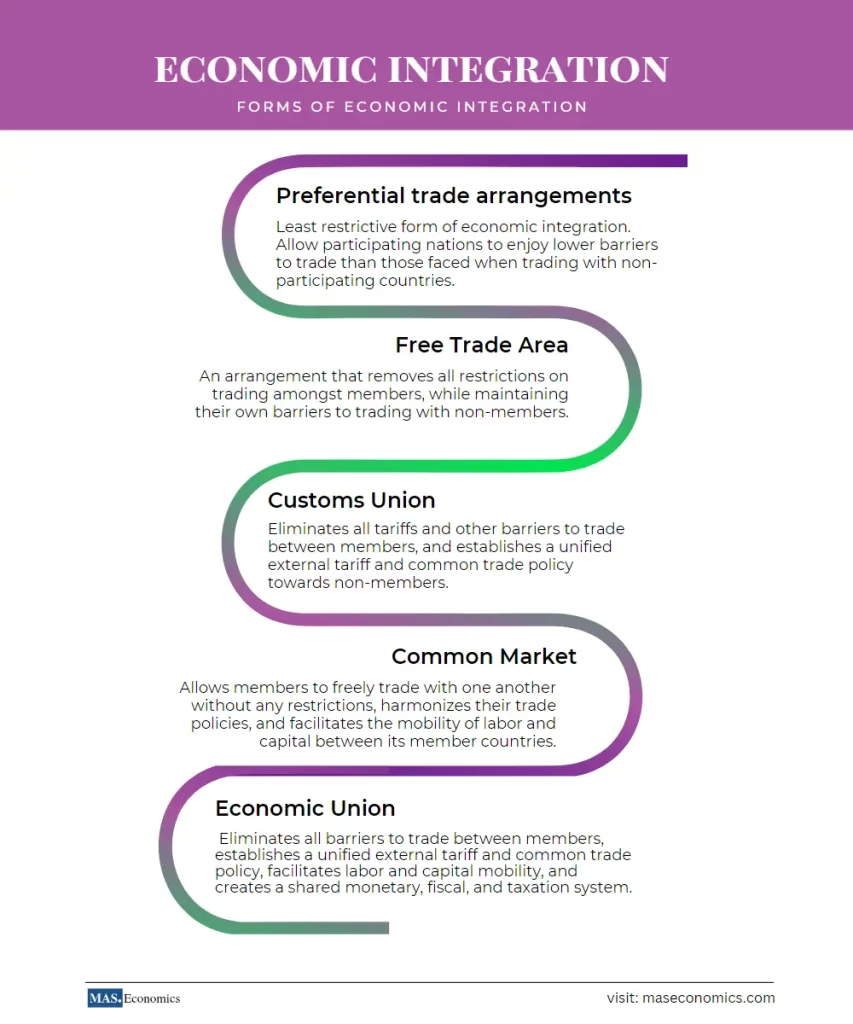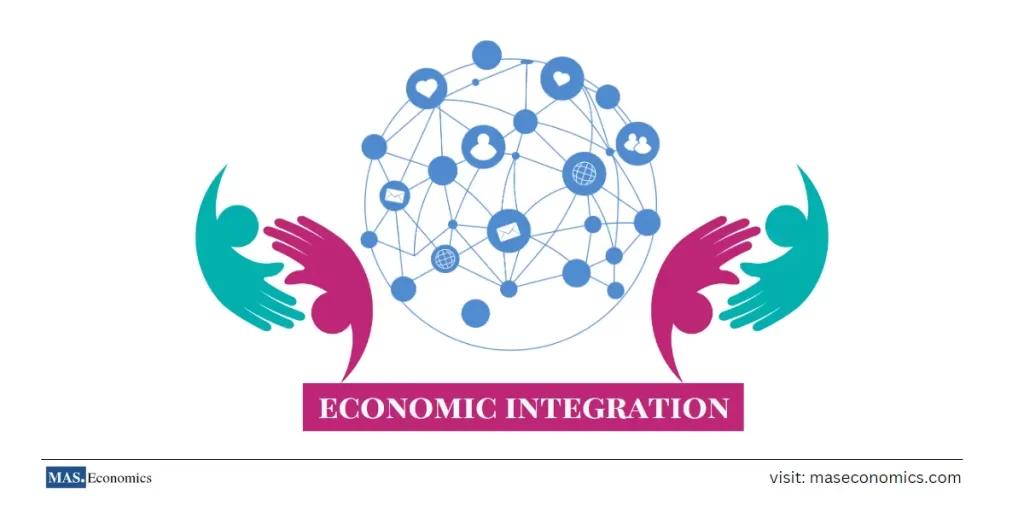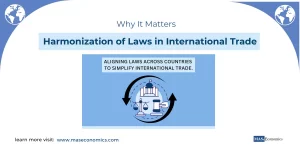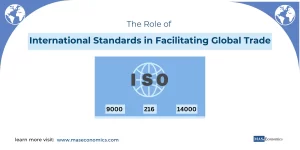Economic integration is the process of reducing barriers to trade and promoting economic cooperation among countries. It can take various forms, including Free Trade Areas (FTA), customs unions, common markets, and economic unions, depending on the level of economic integration between member countries. This cooperation can be achieved through trade agreements, trade blocs, and regional integration organizations, playing a significant role in facilitating the free flow of goods, services, and capital.
In today’s globalized world, economic integration has become one of the key drivers of globalization, increasing economic interdependence among countries. This trend not only enhances growth opportunities but also comes with its share of challenges and complexities.
In this guide, we will explore the different forms of economic integration, their potential benefits and drawbacks, and how trade creation and trade diversion affect participating countries and the global economy.
What is Economic Integration?
Economic integration refers to agreements between countries that promote the elimination or reduction of trade barriers and foster economic cooperation. These arrangements range from minimal collaboration through trade agreements to full economic unions where nations share common policies and institutions.
But before diving into the specifics of economic integration, let’s define an essential foundation:
What are Trade Agreements?
Trade agreements are legally binding documents that reduce barriers between countries and promote economic cooperation. These agreements may involve governments, businesses, unions, and other stakeholders and cover topics such as tariffs, non-tariff barriers, intellectual property protection, and services. By fostering collaboration, trade agreements lay the groundwork for various forms of economic integration.
Different Forms of Economic Integration
Economic integration can take various forms depending on the depth of cooperation between countries:
Preferential Trade Arrangements (PTAs)
Preferential Trade Arrangements (PTAs) are the most basic form of economic integration. In PTAs, countries agree to lower or eliminate tariffs on a selected range of goods and services for each other. However, unlike more advanced forms of integration, the tariff reductions are limited to specific products, and member countries do not necessarily have to extend these preferences to non-member nations.
Example: The Generalized System of Preferences (GSP) is a type of PTA that allows developing countries to benefit from reduced tariffs when exporting certain goods to developed countries like the U.S. or the European Union. This arrangement helps developing nations improve their export performance and boost economic growth without needing to open their markets fully.
Benefits:
- It enhances economic ties and cooperation between member countries.
- PTAs provide developing nations with better access to larger markets.
Drawbacks:
- PTAs can create trade imbalances, as non-member countries may be left out, reducing their market share and trade volume.
Free Trade Areas (FTAs)
A Free Trade Area (FTA) is a more advanced form of integration where member countries eliminate tariffs and other trade barriers on goods and services traded between them. Each country, however, maintains its trade policies with non-member countries. This flexibility allows nations to tailor their trade agreements to fit their economic needs while benefiting from enhanced intra-regional trade.
Example: The United States-Mexico-Canada Agreement (USMCA) (formerly known as NAFTA) allows goods like machinery, agricultural products, and textiles to move tariff-free across U.S., Canadian, and Mexican borders. However, these countries can impose their tariffs on imports from non-member nations like China or Japan.
Benefits:
- Encourages more efficient production as companies can specialize in producing goods for a larger regional market.
- Provides consumers with a wider variety of goods at lower prices.
Drawbacks:
- While tariffs are removed within the FTA, non-member countries may still face barriers, leading to trade diversion, where countries within the FTA buy goods from member nations even if cheaper options exist outside the FTA.
Customs Union
A customs union goes a step further than an FTA by not only eliminating tariffs between member countries but also establishing a common external tariff (CET) on goods coming from non-member countries. This means that all member nations adopt the same tariff rates for imports from non-member countries, creating a unified trade policy.
Example: The European Union’s Customs Union is a prime example of this form of economic integration. Goods move freely between EU member states like France and Germany without tariffs, but non-EU countries like the U.S. or China face a standardized tariff when exporting to any EU member country.
Benefits:
- Promotes deeper economic cooperation and consistency in trade policy across member states.
- Reduces the risk of trade deflection, where goods would otherwise be routed through a low-tariff country to avoid higher tariffs.
Drawbacks:
- The interests of smaller or developing nations within the customs union may not always align with those of larger economies.
- Countries lose some sovereignty over their individual trade policies, as they must align with the common external tariff.
Common Market
A common market represents a further stage of economic integration, in which not only are tariffs and barriers to trade in goods and services removed, but free movement of labor and capital is also permitted. This allows people, businesses, and investments to move freely across member countries’ borders, fostering deeper cooperation and collaboration.
Example: The European Economic Area (EEA), which includes EU member states and several non-EU countries, allows workers from Spain, for instance, to seek employment in Norway with minimal restrictions. Additionally, businesses can operate freely across borders, and capital can move without limitations.
Benefits:
- It helps optimize resource allocation, as businesses and workers can relocate to where they are most productive.
- Encourages more innovation, collaboration, and investment as businesses can operate across a larger market.
Drawbacks:
- The increased movement of labor and capital may lead to economic and social challenges, such as job displacement or wage suppression in certain regions.
- It can lead to labor market imbalances, where workers may migrate from less developed regions to more prosperous areas, causing regional disparities.
Economic Union
An economic union is the most comprehensive form of economic integration, combining the features of a common market with additional integration in areas such as fiscal policy, monetary policy, and even political governance. In an economic union, countries may share a common currency and central authority that regulates economic policy across the region.
Example: The Eurozone, comprising 20 of the 27 European Union countries, is an economic union where member states share a single currency (the Euro) and adhere to common fiscal and monetary policies managed by the European Central Bank.
Benefits:
- Enhanced coordination and stability due to unified policies, making economic shocks easier to manage.
- The use of a common currency eliminates exchange rate fluctuations between member countries, reducing the cost of doing business.
Drawbacks:
- Economic unions require a high degree of political and economic cooperation, which can be difficult to maintain, particularly when countries have varying economic needs or face different challenges.
- Countries lose significant control over their own monetary and fiscal policies.

Trade creation Vs. Trade diversion
Trade creation and trade diversion are critical concepts in economic integration, helping us understand the effects of trade agreements on global trade and the economies of member and non-member countries.
Trade Creation
Trade creation occurs when economic integration, such as forming a Free Trade Area (FTA) or Customs Union, leads to a shift in consumption from higher-cost domestic products to lower-cost imports from member countries. This happens because the removal or reduction of trade barriers (such as tariffs) between member countries allows for more efficient allocation of resources, resulting in cheaper and more abundant goods and services.
Example: Suppose the U.S. and Canada form a free trade agreement. Before the agreement, the U.S. might produce cars domestically at a higher cost than Canada. After removing tariffs, the U.S. imports cheaper Canadian cars, creating trade. Consumers in the U.S. benefit from lower prices, and Canada can specialize in car manufacturing, leading to increased production and economic growth.
Benefits of Trade Creation:
- Lower prices for consumers due to increased competition and efficiency.
- Better resource allocation, as countries focus on producing goods where they have a comparative advantage.
- Increased economic growth and job creation in industries that experience higher demand within the trade bloc.
Trade Diversion
Trade diversion, on the other hand, occurs when a trade agreement leads to the replacement of lower-cost imports from non-member countries with higher-cost imports from member countries due to the preferential treatment given to the latter. Although trade diversion can benefit member countries, it can distort global trade by favoring less efficient producers.
Example: Consider the same free trade agreement between the U.S. and Canada. Before the agreement, the U.S. imported cheaper cars from Japan. After the agreement, U.S. consumers shifted to buying Canadian cars, even though they are more expensive than Japanese cars. This results in trade diversion, where the trade bloc’s preferential treatment disrupts more efficient global trade patterns.
Drawbacks of Trade Diversion:
- Global inefficiencies as consumers may shift to higher-cost goods from member countries, ignoring more competitive prices outside the bloc.
- Non-member countries may lose market access and face declining exports due to preferential trade arrangements within the bloc.
Overall, the net impact of a trade agreement depends on the balance between trade creation and trade diversion. Economies benefit the most when trade creation outweighs trade diversion, as this leads to lower prices, better resource allocation, and increased competition.
Free Economic Zones (FEZs) vs. Special Economic Zones (SEZs)
Both Free Economic Zones (FEZs) and Special Economic Zones (SEZs) are designated areas where governments provide special incentives to attract foreign businesses. These incentives, which include tax benefits, fewer regulations, and infrastructure support, aim to boost economic growth and foreign investment. However, while FEZs and SEZs share similar goals, they often differ in their specific objectives, areas of focus, and the incentives provided.
Key Differences:
Objectives
FEZs are primarily designed to boost economic growth through external trade and investment, while SEZs may target additional objectives like promoting exports, encouraging technological innovation, or fostering the development of specific industries.
Geographical Focus
FEZs can be located in a wide range of areas, including towns and cities, and may target specific industries like logistics, manufacturing, or finance. SEZs, on the other hand, are often centered around urban areas and may either concentrate on particular sectors or take a more holistic approach to economic development.
Incentives
While both FEZs and SEZs offer tax breaks, fewer regulations, and access to better infrastructure, SEZs may provide additional incentives like customs duties waivers, access to government support or grants, and more comprehensive tax relief to encourage long-term investment in targeted sectors.
How FEZs Work:
Governments establish FEZs to enhance their global competitiveness by providing businesses with special incentives to operate within these zones. FEZs are often located near ports, airports, or major transportation hubs to facilitate trade and export activities. Companies operating within these zones enjoy reduced taxes, simplified customs procedures, and access to state-of-the-art infrastructure, making it easier for them to engage in international trade.
Key Features of FEZs:
- Tax Breaks and Incentives: FEZs offer significant tax advantages, including reductions in profit, capital gains, and import/export taxes, making it easier for businesses to compete globally.
- Fewer Regulations: Regulations on labor and environmental standards are often relaxed within FEZs, providing businesses with the flexibility needed to grow.
- Infrastructural Support: FEZs offer access to critical infrastructure, such as roads, ports, and airports, significantly reducing logistical costs for companies involved in global trade.
Examples of FEZs:
Shanghai Free Trade Zone (FTZ), China
Established in 2013, this FTZ provides businesses with reduced trade barriers and tax incentives, fostering China’s deeper integration into the global economy.
Dubai World Central (DWC), UAE
Focused on logistics, aviation, and transport industries, DWC offers tax exemptions, simplified customs, and access to international markets, enhancing Dubai’s global trade and investment profile.
Gwadar Free Zone, Pakistan
As part of the China-Pakistan Economic Corridor (CPEC), this FEZ is designed to boost trade and investment in Pakistan’s coastal region, offering tax exemptions and other incentives to businesses.
Benefits of FEZs:
- Attracting Foreign Investment: FEZs draw in foreign companies, which in turn generate jobs, foster technology transfer, and increase trade volumes.
- Job Creation: FEZs help create employment opportunities, boosting local economies and improving living standards.
- Boosting Exports: By offering tax incentives and logistical support, FEZs encourage the export of goods, contributing to economic growth.
Drawbacks of FEZs:
- Uneven Development: The focus on specific regions can lead to economic imbalances, with only certain areas benefiting from investment.
- Environmental and Labor Concerns: Relaxed regulations can sometimes result in labor exploitation and environmental degradation, especially in less-developed regions.
Other Important Concepts in Economic Integration
Beyond the core forms of economic integration, several other concepts play crucial roles in shaping international trade and cooperation:
Trade Bloc
Trade blocs are agreements between countries designed to foster economic integration and mutual benefits. These blocs can range from free trade areas (FTA) to economic unions and are intended to increase cooperation, trade, investment, job creation, and lower consumer prices. However, trade blocs can present challenges, such as the potential for job relocation from higher-standard nations to those with lower labor and environmental protections.
Examples of trade blocs include the European Union (EU) and NAFTA (now USMCA). These trade blocs help member nations streamline trade policies and bolster regional cooperation, although they may lead to uneven economic benefits among participants.
Regional Integration
Regional integration refers to economic cooperation between countries in a specific region, often taking the form of accessible trade areas, customs unions, common markets, or economic unions. Regional integration aims to boost trade and investment, create jobs, and lower prices for consumers. However, like trade blocs, regional integration can have downsides, such as displacing jobs or businesses in countries with weaker labor and environmental protections.
Examples of successful regional integration efforts include the Association of Southeast Asian Nations (ASEAN) and the African Union (AU), both of which aim to increase economic cooperation among their member states.
Conclusion
Economic integration drives global trade, fosters cooperation, and promotes growth among nations. From PTAs to Economic Unions, each form of integration offers unique benefits like increased competition, lower prices, and enhanced specialization, while also posing challenges like trade diversion and regional disparities. Free Economic Zones (FEZs) and Special Economic Zones (SEZs) further illustrate how targeted policies can boost foreign investment and trade, though they come with risks.




